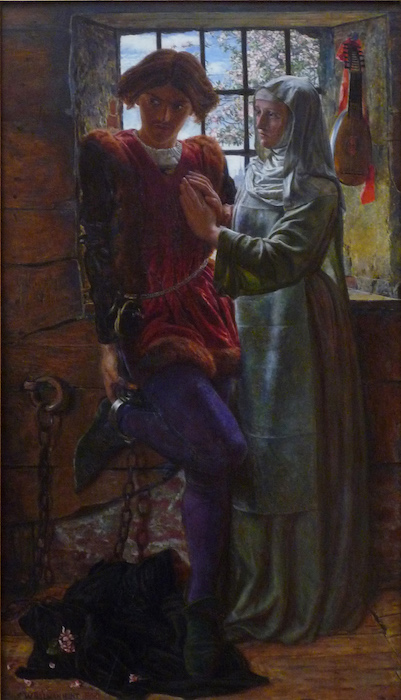William Holman Hunt, Claudio and Isabella, 1850, oil on mahogany, 758 x 426 x 10 mm (Tate Britain)
From William Shakespeare’s Measure for Measure, Act III, scene 1 (a room in a prison):
ISABELLA What says my brother?
CLAUDIO Death is a fearful thing.
ISABELLA And shamed life a hateful.
CLAUDIO Ay, but to die, and go we know not where;
To lie in cold obstruction and to rot;
This sensible warm motion to become
A kneaded clod; and the delighted spirit
To bathe in fiery floods, or to reside
In thrilling region of thick-ribbed ice;
To be imprison’d in the viewless winds,
And blown with restless violence round about
The pendent world; or to be worse than worst
Of those that lawless and incertain thought
Imagine howling: ’tis too horrible!
The weariest and most loathed worldly life
That age, ache, penury and imprisonment
Can lay on nature is a paradise
To what we fear of death.
ISABELLA Alas, alas!

William Holman Hunt, Claudio and Isabella, oil on canvas, 1850, 30 x 16-3/4 inches (Tate Britain, London). Exhibited at the Royal Academy in 1853.
A moral dilemma
William Holman Hunt’s Claudio and Isabella illustrates not only the Pre-Raphaelite fascination with William Shakespeare, but also the artist’s particular attraction to subjects dealing with issues of morality. Taken from the play Measure for Measure, which tells the story of Claudio, who has been sentenced to death by Lord Angelo (the temporary ruler of Vienna) for impregnating his fiancée.

Claudio and Isabella (detail), William Holman Hunt, Claudio and Isabella, 1850, oil on mahogany, 75.8 x 42.6 cm (Tate Britain, London)

William Holman Hunt, The Awakening Conscience, 1853, oil on canvas, 76 x 56 cm (Tate Britain, London)
Claudio’s sister Isabella, a nun, goes to Angelo to plead for clemency for her brother and is shocked that he suggests that she trade sex for her brother’s life. Of course, she refuses, and Claudio initially agrees with her decision, but later changes his mind. Hunt depicts the moment when the imprisoned Claudio suggests that Isabella sacrifice her virginity to gain his freedom.
It was the type of subject that appealed to Hunt, who liked themes to do with questions of guilt and sinful behavior, such as his well known painting The Awakening Conscience (1853).
Claudio and Isabella
Claudio’s face, which is partly in shadow, looks down and away from his sister. His slouching posture, the rich texture of his dark, yet colorful clothes and pointed medieval-looking shoes are a sharp contrast to the stark white of the nun’s habit, her upright posture and unwavering gaze. Sunlight from the prison window lights Isabella’s face and permits a glimpse of apple blossoms and a church in the distance.
The interior of the scene was painted at Lollard Prison at Lambeth Palace, and the crumbling masonry around the windows and the rusty metal of the shackle that bind Claudio’s leg detail the less than desirable conditions.

Shackle (detail), William Holman Hunt, Claudio and Isabella, 1850, oil on mahogany, 75.8 x 42.6 cm (Tate Britain, London)
Hunt also painted the lute hanging in the window while at the prison. The lute with its red string is symbolic of lust, but the fact that it is placed in the sunshine rather than the gloom of the cell lessens the negative impact. The petals of apple blossom scattered on Claudio’s cloak on the floor, although not added until 1879, are intended to show that Claudio is willing to compromise his sister to save himself.
Financial difficulties
Claudio and Isabella was begun in 1850 after Hunt received a small advance from the painter Augustus Egg. Poor reviews of the Pre-Raphaelite paintings at the Royal Academy of 1850 had created financial difficulties for Hunt. He continued to work on the painting for the next several years, finally exhibiting the picture at the Royal Academy of 1853.
“Death is a fearful thing”
The painting appeared with a quotation from the play carved into the frame, a devise Hunt was to explore in many of his paintings, as a way of reinforcing his message. The short notation “Claudio: Death is a fearful thing. Isabella: And shamed life a hateful,” serves not only to point to the exact moment in the play, but also as a reminder of the underlying moral dilemma of the subject. The ability to bring to life these moments of ambiguity was one of Hunt’s greatest achievements.
Additional resources
Professor Rusche on this painting
Pre-Raphaelite Online Resource from Birmingham Museums & Art Gallery
This painting on the Google Art Project
Smarthistory images for teaching and learning:
[flickr_tags user_id=”82032880@N00″ tags=”claudio and isabella,”]

